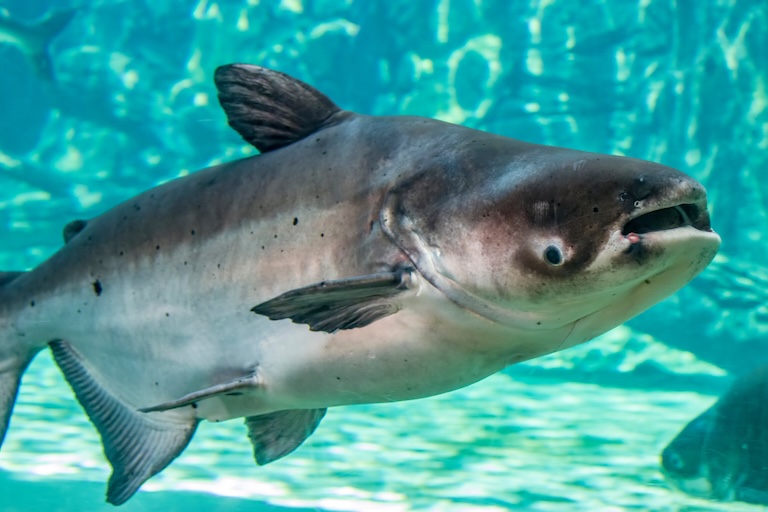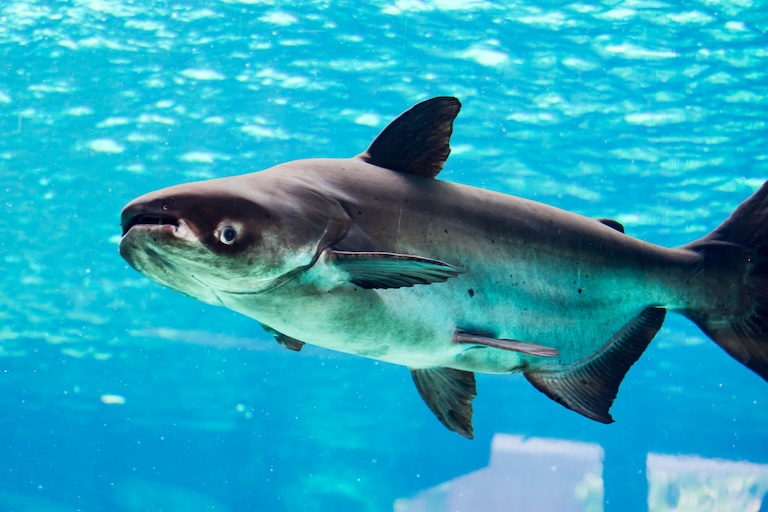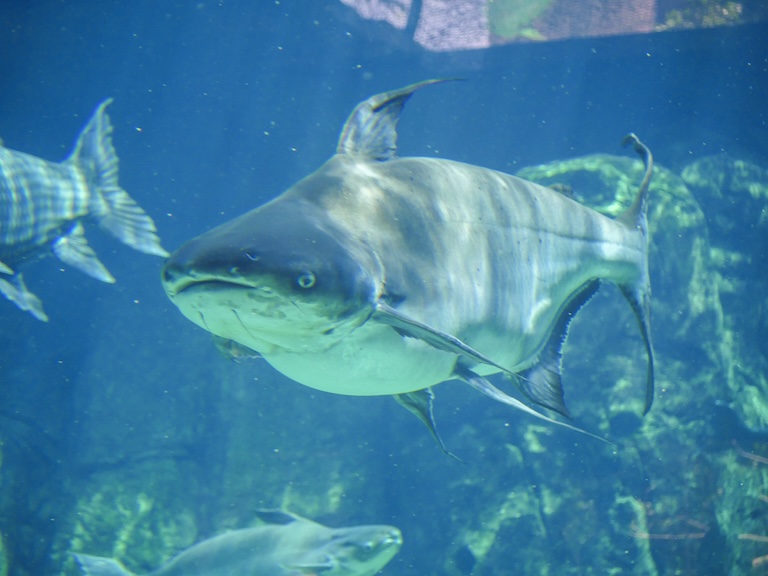Mekong Giant Catfish Profile
The mighty Mekong River traces the entirety of Laos’ Western border, and is the third-longest river in Asia, spanning from Tibet, through China, Myanmar, Laos, Thailand, and Cambodia and emerges in Vietnam’s Southern “Nine Dragons estuary”.
Around a quarter of fish found here are found nowhere else on the planet, and the length of this river was once home to some incredible freshwater giants, whose immense range extended upstream 4,800 km, as far North as China, but today is restricted to a small and dwindling population in the Middle region of the river, around where it meets Tonle Sap in Cambodia.
This critically endangered catfish has been decimated by the expansion of human developments across this range, and to this day still threatens the species.

Mekong Giant Catfish Facts Overview
| Habitat: | Deep, long stretches of river |
| Location: | Endemic to the Mekong River |
| Lifespan: | Estimates range from 10 to 30 years |
| Size: | Up to 3 m (9.8 ft) long |
| Weight: | Up to 350 kg (770 lb) |
| Colour: | Dark grey on top, lighter grey underneath |
| Diet: | Algae, detritus, small animals |
| Predators: | Humans |
| Top Speed: | Slow |
| No. of Species: | 1 |
| Conservation Status: | Critically Endangered |
The Mekong is home to some incredible wildlife, and this giant catfish is both one of the most charismatic and the most endangered.
As a huge, slow-growing migratory species, it is vulnerable to all kinds of threats, and faces many of them today.
And with a conspicuous lack of updated information about the species, it is in serious danger of extinction. This is a riverine monster that has shared its habitat with people for thousands of years and it’s looking like it’s finally on the way out.
Interesting Mekong Giant Catfish Facts
1. They’re massive
Mekong giant catfishes are members of the shark catfish family, and these are found all over Asian freshwater and brackish water systems, being one of around 36 catfish families in their order.
Of the lot, the Mekong giant is the largest, and it’s one of the largest freshwater fish in the world. These chunky animals grow up to three metres long and can weigh over 300 kg.
Being a shark catfish, you’d think they’d be dangerous, but these are very gentle giants.

2. They got no teeth
Being so isolated and understimulated for thousands of generations, rural folk in the UK have developed some interesting pastimes over the years. In the West, they take great pride in chasing a lump of cheese down a hill.
In the Northwest, they took to leprechaun stick prancing and called it Morris Dancing. In the midlands, they simply made funny faces at one another and they called this gurning.
Gurning involved sucking in your gums and blowing out your cheeks and essentially looking like a spoiled apple.
It was invented in the 1200s at a crab fair by exactly the kind of people who would invent such a thing as a crab fair in the first place. The most successful gurners have no teeth to get in their way and are able to pull faces that make them look a lot like the Mekong giant catfish.
That’s because the fish also has no teeth.
Unlike most catfish, it has no barbels, either, and these are the whiskers that gave the order its name. Instead, the Mekong giant has no need for such devices, as it feeds predominantly on algae and plant matter, perhaps sucking up some invertebrates along the way, but generally sticking to a vegan diet.
This lack of teeth and whiskers gives it a distinctly gummy appearance.
3. They can breathe air
This species is known to be capable of what’s known as facultative air breathing. This is essentially something to do when the oxygen in the water is too low to fulfil its needs.
Air breathing shows up a lot in fish, and varies a lot in its mechanisms, but is typically something that involves a highly vascularised surface in the stomach that can extract oxygen from the air similar to a lung, but less efficient.
It’s a great backup in muddy, hot waters where oxygen levels can fluctuate. 1
4. They’re not well understood
Despite being the largest fish In Cambodia, the Mekong giant catfish is not well studied. The Mekong is, for one thing, enormous, but the muddy and crowded habitat of this fish and its long migratory behaviour contribute to its elusiveness.
It inhabits deep water in the river, usually choosing locations where the water is over 10 metres deep, and while there’s some evidence of it spawning in Northern Thailand and migrating down to Cambodia, the extent of its migrations is still not known. 2

5. They mature slowly
One thing that is known, is that these giants take a very long time to reach sexual maturity. From hatching to reproducing can take up to 17 years; a phenomenally long period for an animal with so many threats.
Generation length in the wild isn’t known but could be as much as 35 years, as it is in captive fish. Estimates do have it as low as 15 years, but it is ultimately something that we just can’t tell yet. 3
6. They’re shown in ancient paintings
This species was once prevalent up and down the Mekong, and this is evidenced by ancient artworks that depict it. In Thailand, rock art on cliffs from 3,000 years ago, shows this fish alongside other animals like turtles and strange, hominid figures around it.
It is also present in local folklore up and down the river, showing that it was once a big part of life there. Sadly, this is no longer the case.
7. They’re extremely vulnerable
Fishing is the major threat to this species, and its slow growth rate means it cannot recover from the current rates of harvesting.
It is now very rare across most of its range, and this issue is compounded by the dams, navigations and habitat conversion in many parts of the river.
Dams in particular, block the migration routes of the fish and destroy countless breeding grounds of this, and many other species.
8. Conservation is underway
Thailand has set up a breeding program with the aim of restocking the river, and in Cambodia, buy and release programs were established around the Tonle Sap River, which connects to the Mekong in Phnom Penh.
Studies are ongoing to figure out the distribution and habits of wild populations but measures to safeguard its routes are still lacking.
Sadly, this species is now critically endangered and in decline.
Mekong Giant Catfish Fact-File Summary
Scientific Classification
| Kingdom: | Animalia |
| Phylum: | Chordata |
| Class: | Actinopterygii |
| Order: | Siluriformes |
| Family: | Pangasiidae |
| Genus: | Pangasianodon |
| Species: | gigas |
Fact Sources & References
- “Mekong giant catfish”, Fishbase.
- Zeb S. Hogan (2004), “Threatened fishes of the world: Pangasianodon gigas Chevey, 1931 (Pangasiidae)”, Department of Fish, Wildlife, and Conservation Biology, University of California.
- “Mekong Giant Catfish”, IUCN Red List.
